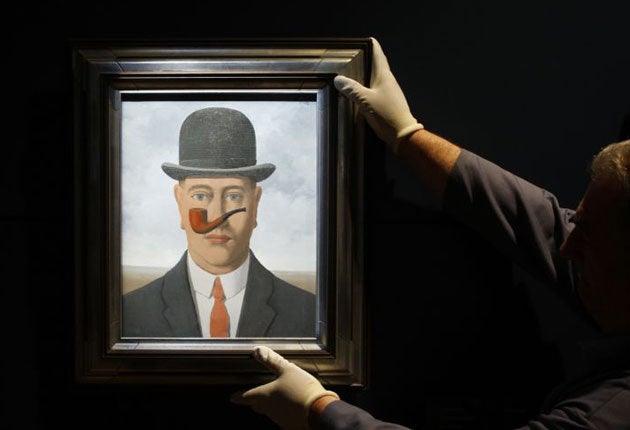Where are all the best postcards at the Magritte Museum? Put that in your pipe and smoke it
Plus: OMG –WTF is this TPM thing? And, Paul Noble: genius squared with madness

The other day I caught Rachel Whiteread's contribution to Front Row's excellent series, Cultural Exchange, in which a variety of contemporary artists across all fields talk about a single artwork that has been influential to them. Whiteread's selection was a Bridget Riley painting called Fall, or rather a postcard of Fall, which Whiteread had carried around with her as a kind of talisman for years. It lead to a brief discussion of the art postcard as a modern form of cultural souvenir – and, by coincidence, it chimed with a recent postcard disappointment of my own, after visiting the Magritte Museum in Brussels for the first time a few days before
The disappointment wasn't a novel experience. Sutcliffe's Law of the Museum Shop states that the availability of a postcard is likely to be in inverse ratio to your desire to possess it. You conceive a passion for a particular painting but when you go to buy a reproduction you discover that it hasn't made it into the postcard rack's Greatest Hits. It sometimes makes you wonder a little who decides what makes the cut and what doesn't.
Do the curators of the exhibition just pick their favourites? Or is a panel convened to weigh up the likely sales figures for individual works? I'm guessing that anything with a cat on it has a serious advantage in this Darwinian contest of marketplace fitness.
In this particular case, though I wasn't entirely surprised that it wasn't in the rows of miniaturised Magrittes. There were empty gaps in the racks, so it's possible they'd simply sold out on the day I went. But I'm guessing not, since the picture was a complete surprise to me and I couldn't even find it in a Google image search. I'd entered variations on the phrase "Magritte Penis Pipe". But though I got a lot of his most famous pipe – and was directed by a convoluted route to a less famous one – I couldn't find the picture I'd seen at the museum. Perhaps it's just been deemed too shocking for widespread reproduction though – because it was startling. The bowl was almost identical to the one that features in The Treachery of Images, the painting which includes the caption "Ceci n'est pas une pipe" – but in this version the stem had been replaced by an erect penis.
It's quite tricky to think of an occasion for which a postcard version of this image would provide the perfect fit. Because, like other great surreal combinations, it's unsettling to look at. I found myself thinking of Meret Oppenheim's fur-covered cup and saucer, a similar collision of the tactile and the sexual, of genital metaphor and perturbing concrete object.
Magritte was making a verbal joke, I guess, since "faire la pipe" is one French term for fellatio. And you could easily object that the image doesn't deserve wider exposure because it makes explicit what lurks beneath the surface of The Treachery of Images.
It is, perhaps, just too obvious in its yoking of the inanimate and the animate, even a little crass in the way that it thrusts its meaning in your face (part of its effect comes from the fact that it is all but impossible to look at an image of a pipe without thinking, at some level, of the act of smoking one).
It isn't the only pipe/penis visual pun Magritte drew. There's another odd image in which a smoker's penile nose droops into the bowl of the pipe he's smoking, like a tobacco tamper. But that has none of the disturbing incongruity of the picture I'm talking about, which is altogether more jarring. And it disrupts the sense of Magritte as the most family-friendly and respectably bourgeois of the Surrealists (the furniture of his dream world is usually so municipal).
Maybe that's why it isn't available as a take-away. It wasn't that they thought that sales would be too slow. It's that they feared they might be unsettlingly high.
OMG –WTF is this TPM thing?
I'm not sure whether to be fascinated or appalled by SecondSync, a company which offers a sort of instant cardiogram of audience reaction to television shows based on analysis of tweets about them. On the one hand it's fun to look at their daily leaderboard of most tweeted programmes, which includes a record of the peak tweet-per-minute (TPM) rate and a graph registering surges in WTFs and OMGs (I'm guessing the Matterhorn spike in 127 Hours coincided with the penknife work). On the other hand how much worse could television get if commissioning editors start to compete for high TPM moments?
Genius squared with madness
I wasn't entirely convinced by the Hayward's Alternative Guide to the Universe exhibition, as fascinating as some of its exhibits were. But it was intriguing to discover just how hard it is to distinguish between artists and outsider artists. Fixed obsession with one subject and style? Well what about Rothko or Mondrian's work? Fascination with imaginary worlds and cityscapes? I give you Paul Noble, Turner Prize-shortlisted for his drawings of Nobson Newtown. Conviction that their work illuminates a hidden truth veiled by the superficial appearances of the world? Virtually every contemporary artist alive. The line between genius and madness isn't just fine. I'm not sure it's there at all.

Join our commenting forum
Join thought-provoking conversations, follow other Independent readers and see their replies